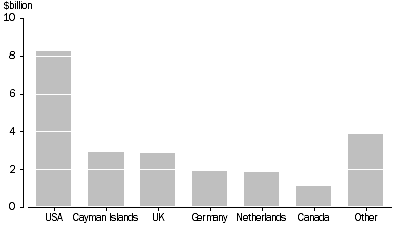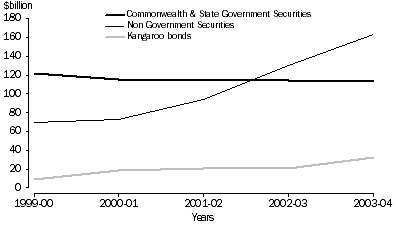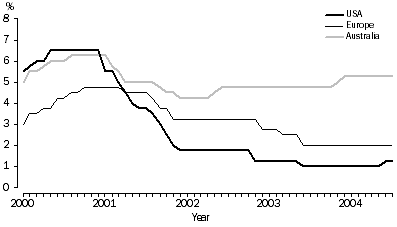Feature Article - Kangaroo Bonds
INTRODUCTION
Kangaroo bonds are long-term debt securities issued by non-residents in the Australian domestic market. They are denominated in Australian dollars, documented to Australian legal requirements, settled through Austraclear and listed on the Australian Stock Exchange.
The rapid growth in Kangaroo bond issues in the Australian market has given rise to an interest in the nature, trend and impact of this type of bond on Australia's international investment statistics. While Kangaroo bonds have been issued for a number of years, this article focusses on the period from 2000-01, when they became significant in terms of Australia's international investment position.
The growth of non-government bonds, such as Kangaroo bonds, is due in part to the reduction of Australian government bond issues. The United States of America (USA) is the primary source of these bonds, while non-resident financial institutions are the dominant issuers in the domestic market. About 70% of Kangaroo bonds are taken up by Australian residents.
This article explains some of the key aspects of this instrument in more detail.
ABOUT KANGAROO BONDS
The International Investment Position (IIP) includes all financial positions and transactions between residents and non-residents. The global bond market may be represented in the diagram below. Debt issues that are in scope of the ABS's Survey of International Investment (SII), which collects data for the compilation of the International Investment Position (IIP), are covered by areas 2, 3, 4 and 7 because they are transactions between residents and non-residents. Of these areas, 2 and 3 represent Australian Investment Abroad, while 4 and 7 represent Foreign Investment in Australia. Areas 1, 5, 6 and 8 are out of scope of the IIP because they represent transactions between residents or between non-residents.
Kangaroo bonds are covered by areas 1 and 2 of the diagram.
KANGAROO BONDS AND THE INTERNATIONAL INVESTMENT POSITION (IIP)
When Kangaroo bonds are taken up by residents of Australia, this represents claims by Australian residents on non-residents, hence Australian Investment Abroad (AIA). It is estimated that approximately 70% of total Kangaroo bond issues are taken up by Australian residents (refer table 1).
1: Issues of Kangaroo bonds taken up by residents of Australia, ($A) |
|  |
 | September quarter | December quarter | March quarter | June quarter | Financial Year Total |  |
 | $m | $m | $m | $m | $m |  |
|  |
| 2000-01 | 802 | - | 2,419 | 1,243 | 4,464 |  |
| 2001-02 | 1,190 | 245 | 1,505 | 140 | 3,080 |  |
| 2002-03 | 560 | - | 168 | 560 | 1,288 |  |
| 2003-04 | 2,030 | 1,568 | 5,257 | 1,785 | 10,640 |  |
|  |
| - nil or rounded to zero (including null cells) |
New issues of Kangaroo bonds taken up by residents are included in long-term portfolio debt securities (bonds and notes) transactions. These appear as debit entries in the financial account of Australia's balance of payments representing an increase in assets. The resident holdings of Kangaroo bonds contribute to assets in the IIP.
For the current quarter, this information is included in Table 25 of this publication. A time series of transactions is presented in Table 24, while a time series of stocks is provided in Table 27. Kangaroo bonds are included in Australian National Accounts: Financial Accounts (5232.0) Tables 16, 32 and 37. They are not separately identified from resident holdings of bonds issued offshore in this publication but are separated in the Financial Accounts. Kangaroo bonds are also reported in the Reserve Bank Bulletin, Table D.4 'Debt securities issued in Australia'. This table includes total Kangaroo bond issues while ABS's IIP only includes those held by residents. The Financial Accounts data separately identifies Kangaroo bonds held by residents from those held by non-residents.
SOURCE OF BONDS
Non-resident financial institutions have been the dominant issuer of Kangaroo bonds for the past four financial years with a total of $19b on issue as at June 2004. This represented 66% of total Kangaroo bond issues (refer table 2). Bond issues from supranational organisations (i.e. organisations that transcend established national boundaries e.g. Eurofima, UN) decreased to only $500m in 2002-03 after $1b worth of Kangaroo bond issues in 2001-02. The decrease coincided with a decrease in Australian investor demand for bonds issued by non-residents. With domestic and global credit growth, most investors preferred high yield securities rather than the status (credit rating) of the international borrower.
2: Issues of kangaroo bonds, ($A) |
|  |
 | Financial | Supranational | Other(a) | Total |  |
 | $m | $m | $m | $m |  |
|  |
| 2000-01 | 4,400 | 1,175 | 850 | 6,425 |  |
| 2001-02 | 1,850 | 1,000 | 1,550 | 4,400 |  |
| 2002-03 | 1,320 | 500 | 20 | 1,840 |  |
| 2003-04 | 11,660 | 1,965 | 2,950 | 16,575 |  |
| Total | 19,230 | 4,640 | 5,370 | 29,240 |  |
|  |
| (a) Other includes government, corporate and other enterprises. |
United States of America residents were issuers of most Kangaroo bonds on issue as of June 2004. Other significant issuers are the Cayman Islands, United Kingdom, Germany, Netherlands and Canada. The largest growth, in absolute dollar terms, between September quarter 2000 and June quarter 2004 came from the USA. The value of bonds on issue grew by almost $21b since September quarter 2000, with issues from USA resident institutions accounting for nearly $8b of this total (see graph 3).
3. Nationality of issuer as at 30 June 2004

TRENDS IN KANGAROO BONDS
From the mid 1990s, Australian Federal and State Governments reduced debt security issues as budget surpluses and privatisation proceeds were used to repay public sector debt. The reduction in government indebtedness meant that there were fewer government bond issues in the bond market. Gross outstanding Commonwealth Government Securities and State Government Securities recorded small decreases from 2000 to 2004 while non-government debt securities grew steadily (refer graph 4). There was a strong build-up of managed funds over the same period, fuelled by superannuation contributions. These funds were valued at $760b as of June 2004. This growth, coupled with the decreasing value of government bonds on issue, stimulated development of the non-government bond market to meet the resulting high demand for debt securities. As of June 2004, there were $164b of long-term non-government bonds on issue, an increase of 25.7% from June 2003.
4. Value of bonds on issue (nominal value)

One of the notable contributors to the growth in the non-government bond market has been the increase in non-resident bond issuers (Kangaroo bonds). Kangaroo bonds issued decreased 58% to $1.8b in 2002-03 from a level of $4.4b in 2001-02. In 2003-04 however, non-resident borrowers entered the bond market with $16.6b issued, of which approximately $11.6b (70%) were taken up by residents.
For Australian investors, Kangaroo bonds have become more attractive as have all high rated corporate bond issues. The credit spread (the price difference between AA bonds from corporate issuers when compared to similarly denominated government issues) significantly decreased in the first half of 2003 and is relatively low at the moment. With the decreasing availability of government bonds, AA corporate bonds are being favoured as the next best alternative in fixed income securities.
This has also lowered the cost of borrowing for corporate borrowers and helped to increase the attractiveness of Australian denominated debt for non-resident issuers.
From the issuer's perspective, the reasons for the increasing levels of Kangaroo bond issues are less obvious given the relative changes in official interest rates since early 2001. Since January 2001, Australian interest rates have been higher than European and USA rates. Over time, the gap has increased with Australia having relatively high interest rates since September 2001 (see graph 5). This makes issuing competitively priced debt securities in the Australian market more expensive than other markets.
5. Official interest rates January 2000 to July 2004

One explanation for this is the reluctance of resident fixed interest fund managers to invest in non-resident markets due to the return not being high enough to justify the extra risk of corporate bonds. This makes funds less available to non-resident borrowers in other markets. This, however, does not explain why non-resident corporations would rather issue debt than borrow from financial intermediaries in low-interest rate countries.
Anecdotally, it is suggested that two main drivers exist in explaining trends in Kangaroo bond transactions. From the issuer's point of view, the first commonly quoted reason for the growth in Kangaroo bonds is a desire to diversify funding. Diversifying currency exposures for issuers lowers the risks associated with foreign borrowings. The second is the widening interest rate basis swap. This widening has effectively made it cheaper for borrowers to hedge against interest rate movements.
 Print Page
Print Page
 Print All
Print All